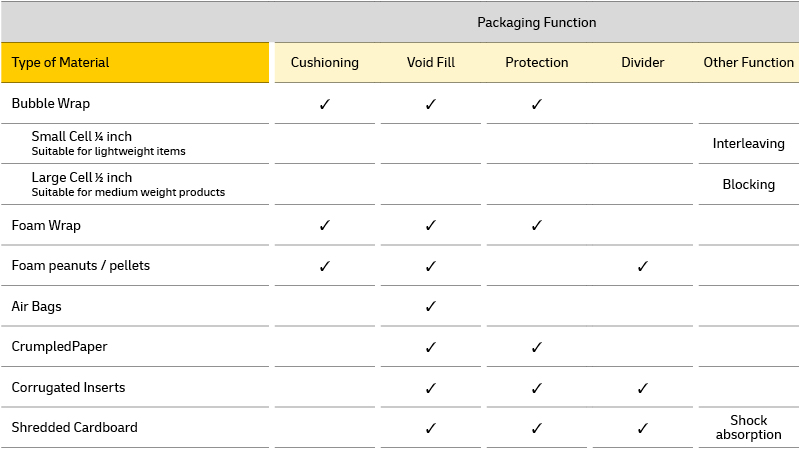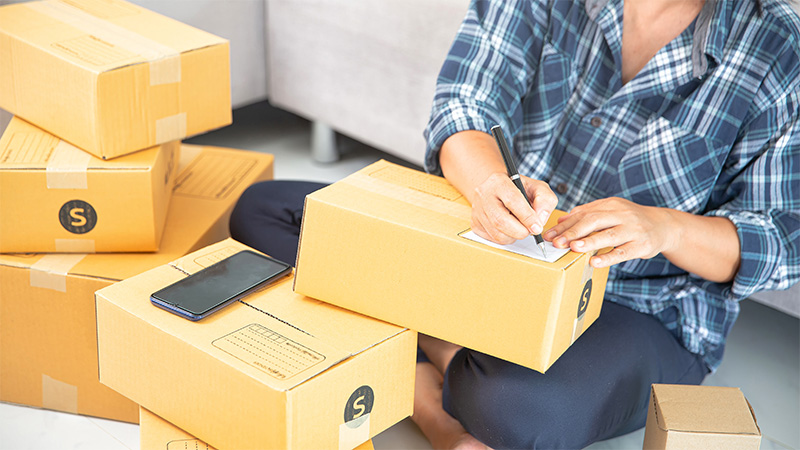Grow your business with the Discover newsletter
Logistics advice & insights straight to your inbox
Subscribe now
How much does your product weigh? How fragile is it? How valuable is it? Does it need controlled conditions, like regulated humidity? Are there any special packaging regulations around it, as with foodstuffs? How much have you factored into the cost of your product for packaging (this will influence your packaging budget)? Did you know that quite innocuous products like perfume or electronics, for example, can be classified as Dangerous Goods and need to be packaged accordingly? All these are things to consider when deciding how to package your items.
There are basically two types of packaging – external and internal. Unless your product requires specialized packaging, like liquids or powders, the external packaging is usually some form of cardboard box. Always choose a high-quality corrugated cardboard box and avoid re-using old boxes as they lose their rigidity.
Internal packaging is used to cushion your product and fill gaps inside the box, to stop the goods moving around. Styrofoam used to be a favorite, but this has now been banned in many countries as it’s so damaging to the environment. There are many different types of internal packaging which have different levels of suitability for cushioning, filling gaps or voids, protection, or as dividers when you’re shipping multiple products in the same box.
Here is a simple chart showing some of your packaging options and what they are best used for.

Not all cardboard boxes are the same, and you need to choose the right type for your external packaging. For heavier or more fragile items, double or triple-wall boxes are more appropriate. There should be a manufacturer stamp which tells you more about the strength and durability of the box or, failing that, consult your box supplier.
For internal protection, biodegradable air peanuts are a greener alternative to styrofoam. Bubble wrap also does a good job of cushioning and protecting your product but, again, this is a traditional plastic-based packaging material and corrugated bubble wrap is a lot greener. Foam wrap, air pillows, crumpled paper, corrugated inserts and shredded cardboard are all other alternatives for protecting your goods – you just need to decide which is most suitable

While packaging’s primary purpose is to protect your product so it can be safely delivered to your Customer, it can also do so much more.
Packaging can be a powerful marketing tool, allowing communication with your Customer when they’re feeling most positive towards your brand – when their order arrives. At its most basic, you can use packaging to bolster your brand image using consistent colors, logos, messaging, typography and other brand elements. While your outer packaging may be a cardboard box, it needn’t just be plain brown! Consider using packing tape in your brand colors and custom-designed labels.
You can also synergize your packaging with your advertising. For example, if you’re running a social media campaign using a particular headline, why not look into adding it to your packaging? You can also cross-promote your social media campaign by adding a hashtag.
Other opportunities include: tying in your packaging with particular events – for example, Valentine’s Day or Christmas; including a personalized, handwritten thank-you card (perhaps with a personal discount code); and adding free samples of related products.
Creative packaging, personalization, free samples and discounts are all powerful ways of encouraging Customer loyalty and repeat purchases.


Returns are a fact of life in the age of e-commerce. While offering free returns has cost implications for your business, many Customers will only shop from retailers who operate a free returns policy. It’s a dilemma you have to weigh up and make a decision about.
Whatever you decide, strangely enough, a return is actually another opportunity for your business. By making it as hassle-free and simple as possible, you will encourage the Customer to buy from you again, even though this particular purchase hasn’t worked out. So always include clear instructions and a returns label. And in terms of the packaging itself, choose a box that is easy to open –perforated for example – and easy to re-use and re-seal, maybe including an adhesive strip.
By putting some thought into it, you can make the returns process a positive customer experience and a way of differentiating yourself from your competitors.

Make no mistake, sustainability is a huge issue among consumers now, and using sustainable packaging could be crucial to the popularity of your brand.
Sustainable, green or eco-friendly packaging are terms that mean the same thing: packaging that has the lowest possible impact on the environment. This low impact is achieved in three basic ways: by limiting packaging waste; by using materials that are recyclable or biodegradable; and by the use of renewable energy in the production of the packaging.
So, what can you do? Most obviously, cut back on waste by using packaging that’s the right size for whatever product you’re sending. Sending a small product in a big box annoys recipients so much that, in the past, they’ve taken to social media to shame companies who do so.
As for packaging materials, new alternatives are being developed all the time. As mentioned above, biodegradable packaging peanuts can be used instead of styrofoam and corrugated cardboard bubble wrap instead of traditional plastic-based bubble wrap. Air pillows made from recycled or biodegradable materials are another alternative. Corn starch could be used instead of plastic. And if only plastic will do, there are now biodegradable and recycled plastics available. Organic ecological textiles are also becoming more popular, includingorganic cotton wool for cushioning, linen and poplin anti-scratch covers, and tape made from hemp.
And finally, try to source cardboard boxes and paper that have been recycled or certified to support sustainably managed forests.
For more details, read our article on green packaging.
Of course, packaging is important. But, no matter how much thought you put into it, it could end up pointless if Customers are disappointed by a needless delay to their shipment or annoyed by surprise additional costs.
We can help you navigate international trade by enabling you to calculate your customs duty, tax and other fees, so you can pay them up front. Plus, you can get the correct HS (Harmonized System) codes and check your shipment’s compliance with any country’s import and export regulations.
You can do it all, using our free Global Trade Services toolkit.
• Assess your product
• Choose appropriate packaging materials
• Ensure your goods are protected
• Use your packaging as a marketing tool
• Make sure it’s returns-friendly
• Choose green packaging alternatives
• Navigate customs with our Global Trade Services toolkit
So, your packaging will ensure your shipment arrives at its destination in one piece, but what about on time? That’s where DHL has you covered. With a DHL Express Business Account, you’ll have access to a range of expedited shipping solutions to help you meet your customers’ expectations.